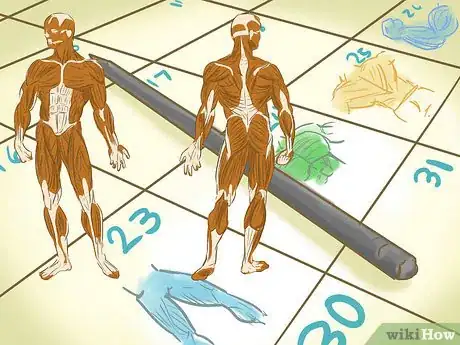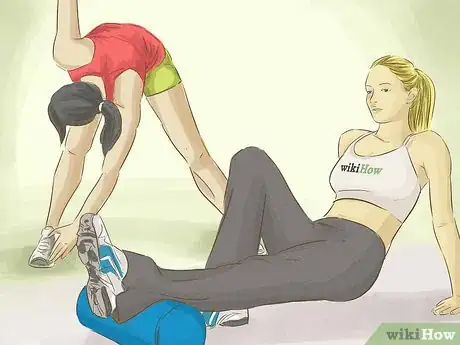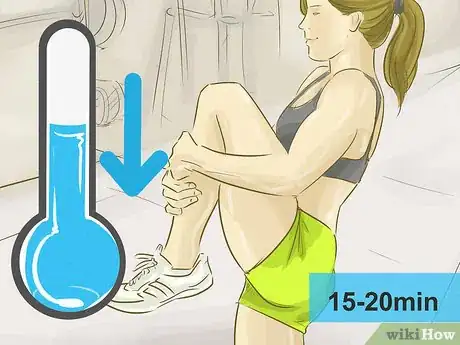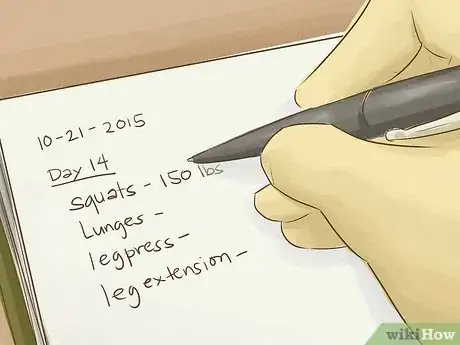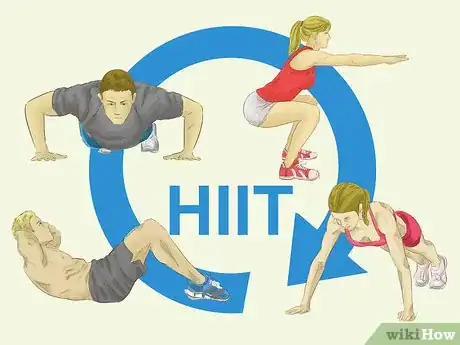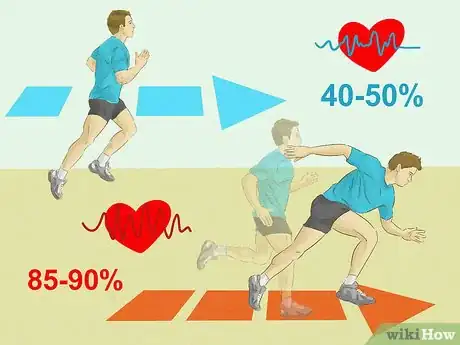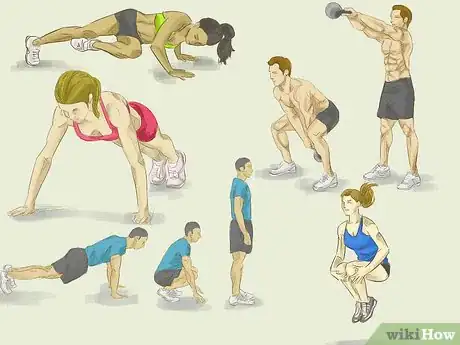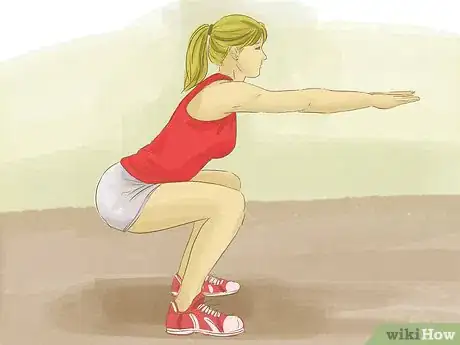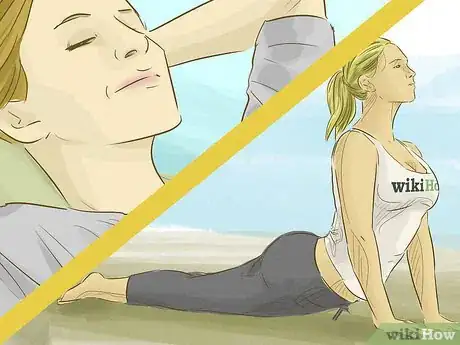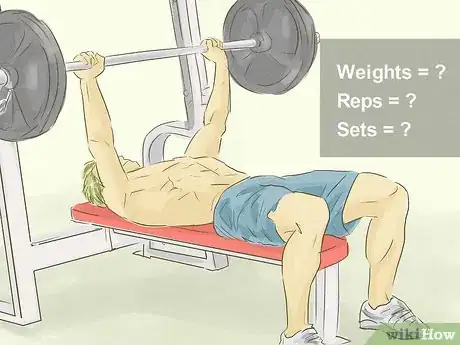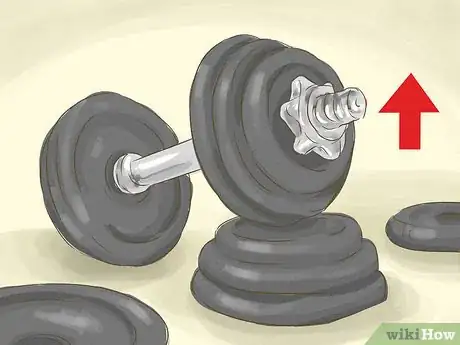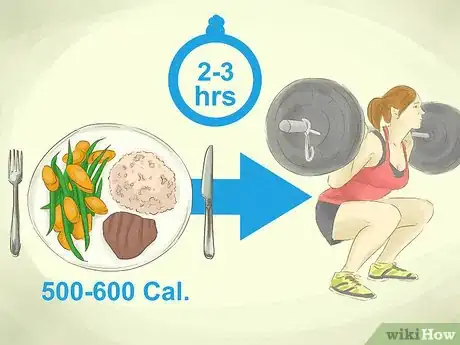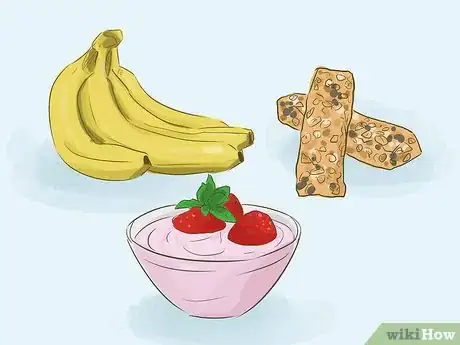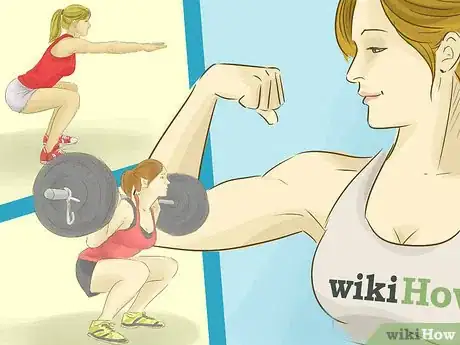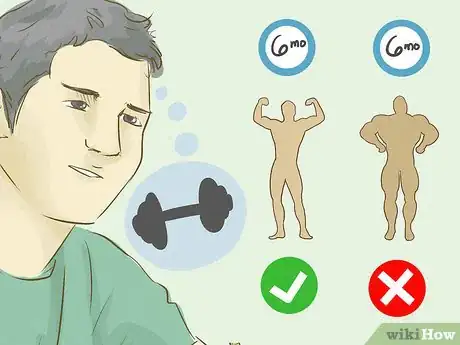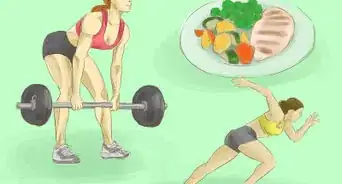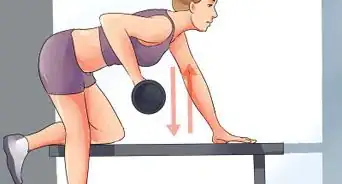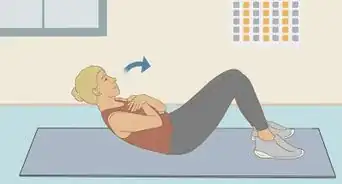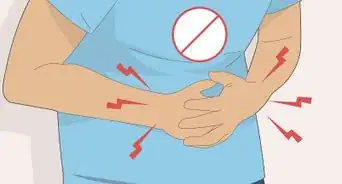This article was co-authored by Errol Ismail. Errol Ismail is a Personal Trainer and the CEO and Co-Founder of Maestro Training. With nearly 10 years of experience, Errol specializes in helping individuals incorporate exercise into their daily lives by making it convenient and creating a community of support and encouragement. Before starting his own company, he honed his craft at at Equinox, one of the most prestigious gyms in the USA.
There are 27 references cited in this article, which can be found at the bottom of the page.
wikiHow marks an article as reader-approved once it receives enough positive feedback. In this case, several readers have written to tell us that this article was helpful to them, earning it our reader-approved status.
This article has been viewed 239,944 times.
For the untrained individual, almost any exercise is beneficial. Integrating a regular exercise routine into your life can help you lose weight, get stronger, reduce stress, reduce health problems, and boost energy.[1] However, many people don't know how to make the most out of their workout. Learn how to maximize your workout benefits with good planning, proper nutrition, rest and a positive attitude.
Steps
Having a Quality Routine
-
1Plan your workout. Before you hit the gym, plan out your workout. Depending on how much time you have available, decide which activities you will focus on. When you know how you’ll spend your time, you won’t waste time hemming and hawing over what to do.[2]
- Remember to split your workouts up for the week. Some people split their body parts into different workout days. Others simply do full body workouts 2-4x/week. Figure out what works best for you and remember to incorporate rest days.
- Be sure to build in some time at the beginning of your workout for warming up. Include time at the end of your workout for cooling down your body.
- Switching up your routine not only confuses the body and provokes growth, but it also ensures that you are getting a well-rounded workout.
-
2Don’t do a routine you are not physically prepared for. While the point of exercise is to grow stronger, it is dangerous to expect your body to perform at a level far beyond your current capabilities right away. Most people who start an exercise regime are very motivated and want to work out every single day. However, for the untrained body, start with a more realistic workout routine, such as three days a week, or approximately 150 minutes of moderate aerobic activity per week. If you want to lose weight, work up to doing about 300 minutes of moderate activity per week.[3]
- Avoid doing intense workouts without a few weeks of preparation. It may seem like a long time, but spending two weeks jogging before doing an intense run can save you from serious physical injury.
Advertisement -
3Warm up. Warming up your body before you exercise will get the blood flowing and brings fluids to your joints. Remember that if you're about to do an activity, giving those muscles a chance to warm up can prevent injury. When you have properly warmed up, you will reduce the possibility of injury and you will also enhance muscle performance.[4] Try this routine for warming up your body:
- Foam rolling: Use a foam roller to massage different parts of your body. Spend a few minutes working on your calves, quads, glutes, upper back, and lats.
- Dynamic stretching: This form of stretching focuses on repetitive motion that stretches a body part further each time it is stretched. Some examples include forward lunges and arm circles.
-
4Don't train until you drop. Training to failure is unnecessary. Training to failure is when you keep pushing your muscles until they fail, like running until you collapse. Many casual exercisers think that this is a good idea, because it pushes their muscles to the 'max'. However, there is no conclusive proof that training to failure boosts muscle growth. In fact, because it damages muscles so heavily, it may hurt your progress.[5]
- Beware of overtraining. This could be during a single session or over the course of a week. Your muscles need time to heal and prepare for the next workout.
-
5Change up your routine. Most casual exercisers know that the body is very adaptive and will quickly build up a 'tolerance' to a workout routine. You may also grow bored with your regular routine and need a change of scenery or movement. Therefore, changing up your regimen every few weeks is an important part in staying fit.[6]
- Changing your routine can also reduce the potential to overuse certain muscles and prevent injury.[7]
- Easy ways to change your routine are to look up new activities that accomplish the goals you want. For example, if you jog for 20 minutes and do 30 crunches, you could instead do short sprints and jumping jacks for 20 minutes followed by five minutes of planks.
-
6Stretch after your workout. Plan to spend about 15-20 minutes cooling down and stretching after you finish your workout. Stretching helps with muscle flexibility and pliability. In turn, this can help you in subsequent workouts to push your muscles a little further.[8]
- Make sure that you allot time to this crucial step; otherwise, you might skip it if you feel rushed.
-
7Remember to stay hydrated. You will want to make sure you are hydrated before, during and after your workouts. After your workout, drink 16 oz for every 20 minutes of strenuous exercise.
-
8Keep track of your progress. Keeping track of your daily progress will help you stay committed to exercising regularly. Carry a notebook with your workout clothes, so you can track how long you jog, how many repetitions you can do, and so on.
- You can also use this journal to keep track of your meals and other factors that impact your exercise and overall health.
Trying High-Intensity Interval Training
-
1Recognize the benefits of high-intensity interval training. High-intensity interval training (HIIT) has been shown to produce excellent benefits for improved cardiovascular health, increased rates of fat burned and muscle strengthening.[9] ,[10] This is one of the key methods for fat loss and can often be added onto the end of a weight lifting workout to maximize calorie expenditure and fat loss. Specific benefits include improvements on:
- Aerobic and anaerobic fitness
- Blood pressure
- Insulin sensitivity (muscles become more efficient)
- Cholesterol profiles
- Fat around abdomen
- Body weight
-
2Establish a base fitness level first. In order to participate in an HIIT workout, you’ll need to get your body into a certain level of shape. If you have not been physically active in a while, you may have an increased risk for coronary disease during high-intensity workouts (for some, this can result in a heart attack).
- Try working out 3-5 times a week. Strive to exercise 20-60 minutes for each session for several weeks. This will improve the function of your muscles and get your heart in shape before you start an HIIT regimen.
-
3Try high-intensity running, biking or swimming. The strategy with high-intensity interval training is to alternate between hard exercise and light exercise within a short amount of time.
- Sprint or bike as hard as you can. You should be breathing hard and you should have a hard time carrying on a conversation.[11] You should aim to reach 85-90% of your maximum heart rate.
- Do a low intensity activity for one minute. Something like walking or jogging in place works well. Aim to reach about 40-50% of your maximum heart rate.
- Repeat this process up to 10 times in one workout.
- Do an HIIT workout 3 times every week.
-
4Plan out a circuit of 6-8 exercises. Work several muscle groups in one workout by setting up a circuit. Combine exercises that work your arms, legs, and core. The total workout time will be roughly 30 minutes. Think of this as interval training in weight lifting form. This is highly beneficial for incorporating cardio while doing weight-bearing exercises.
- Try exercises like burpees, plank-ups, kettlebell swings, tuck jumps (starting in plank position and jumping your feet up to your hands), and twisting push-ups (do a push-up and then twist your leg up under your torso).[12] http://www.huffingtonpost.com/2013/05/18/get-in-shape-fast-hiit-workout_n_3276623.html, [13]
- Do one exercise for 30 seconds, then jog in place for 30 seconds. Then move on to the next exercise and do that one for 30 seconds. Jog in place for another 30 seconds. Once you’ve finished all of the exercises, rest for 60 seconds. Go through the circuit of exercises 1-2 more times.[14]
-
5Try the spring interval training method. This method combines 30-second high-intensity intervals with 4-minute recovery intervals. Try sprinting for 30 seconds and then jog at a comfortable pace for 4 minutes. Repeat these sets 3-5 times for your full workout.
-
6Strive for proper form. HIIT workouts are effective when you have proper form and push yourself to hold a position for the 30-60 seconds that you are doing it.
-
7Make sure to take days off. You risk injuring yourself from exercising too much. HIIT exercise programs can be hard on the body. Give your body a rest regularly. If you are just starting out, try an HIIT workout 1-2 times a week. When you adjust to the challenge of the workout, add in another workout per week.
- You can still exercise on some of your off days. Try for more low- to moderate-intensity workouts.
- Listen to your body and remember that 1-2 rest days per week may not be enough. Especially in times of sickness or stress, remember that your body may need more rest time.
Ramping Up Your Regular Exercise
-
1Mark where you’re at right now. In order to maximize workout benefits, you need to increase the effort you’re giving in your workout. Start by understanding where you are currently at. Then you will be able to track your progress. You might assess your current level by doing one or more of the following:
- Run a half-mile or mile and time yourself.
- See how much weight you can lift or how many reps you can do.
-
2Set a goal. Figure out how you’d like to improve. For example, you might decide to train for a 10K run. You want to lift more weight. You want to not feel winded when you climb stairs. Write down your goal to keep yourself motivated.
- Set short term goals so that they are easier to obtain than the overall long term goal. Celebrate the little milestones and remember that each little win is truly a BIG win!
-
3Determine ways to improve your performance. There are lots of ways to improve how you’re exercising, such as increasing muscle strength, endurance, agility, and so on. Combine different types of workouts to push yourself harder. Think about what you want to achieve with your particular goals.
- For example, if you’re training for a 10K, you can add sprint intervals or train on a hilly course once or twice a week. You might also add weight training or other types of exercise, such as swimming or biking, which can heighten your performance by strengthening your body overall.[15]
- If you play basketball with friends, you can improve your workout by adding drills. Try running lines, passing the ball back and forth, or working on your vertical jump. Increase your stamina by letting the game go a little longer.[16]
- If you play soccer casually, kick it up a notch by working on bursts of speed. Just adding more running can help somewhat, but soccer really relies on explosive power and changing directions quickly. Do short sprints, moving and turning around the field quickly.
-
4Push yourself harder. When you do the same workout over and over, you can get yourself into a slump. The routine becomes easy as your muscles grow accustomed to the motions of your regular exercise. Push yourself by ramping up your training. Do extra reps, sprint for part of your jog, or add a little more weight to your leg presses.
- Consider getting a personal trainer so that you can be assured you will always be pushing forward. Sometimes having someone to hold you accountable is what it takes to bring out the best in you.
Resting Your Body
-
1Recognize that your body needs to rest. Many people are confused about how quickly the body recovers and how often it needs to rest. Remember, when you do any sort of exercise, your muscles tear apart at the molecular level. When they heal, they grow back stronger. However, if you never rest your muscles, they can never heal. Aim to rest for 48-72 hours after strength training.[17]
- If you are just starting out with your exercise regimen, build in extra recovery time to ensure that you don’t injure yourself.[18]
-
2Try gentle exercise after hard exercise days. When you have had an intense workout, your body needs time to recover. This doesn’t mean that you need to stop exercising entirely. You can switch to a gentler form of exercise, such as yoga or Pilates. You can also play recreational basketball or soccer. Focusing on low-impact exercise and stretching can give the body a chance to move in a new way and continue repairing itself.[19]
-
3Get enough sleep. Your muscles will need time to repair themselves, and you need time to recover mentally and physically. Aim to get 7-9 hours of sleep every night. Set good sleep habits to improve the quality of your sleep.[20]
- Try to avoid artificial lights and wake up to natural sunlight.
- Turn off computer and phone screens at least 15-30 minutes before bedtime.
- Pay attention to your circadian rhythm. This is your body clock that dictates your natural sleep cycle.[21]
-
4Track your resting heart rate. Take your heart rate when you wake up in the morning. This is your resting heart rate. If your resting rate is too high, then you may not be allowing yourself sufficient recovery time from exercising.[22]
- Count the number of beats per minute. You can also count the number of beats in 10 seconds and multiply by 6.
- Your ideal resting heart rate depends on your age and fitness level. If you are an athlete, you will likely have a lower resting heart rate (ranging from 49-55 beats per minute for men, and 54-59 bpm for women). A good resting heart rate for non-athletes range from 62-65 bpm for men and 65-68 bpm for women.[23]
Timing Your Meals
-
1Eat proteins and low fiber carbs a few hours before your workout. A low-fat meal with moderate protein and lots of low fiber carbs will help you keep your energy throughout your workout.[24]
- Aim for a small meal of 500-600 calories. Have this meal 2-3 hours before your workout. This will give you a chance to digest some of the meal before you start working out.
- Choose slow-digesting carbs for this meal. Eat sweet potatoes, buckwheat or other similar carbs.[25]
-
2Eat a high-energy snack right before your workout. Give yourself an extra kick of momentum to ramp up your workout. Have a snack with high carbohydrates, such as a banana, energy bar or yogurt. This is especially necessary if you doing HIIT.
-
3Eat again after your workout. Studies suggest that eating within an hour after your workout can increase muscle size and strength. This “window of opportunity” is when muscles need additional nutrients to repair damage and depletion.[26] Carbohydrates are converted into glucose, which your muscles will store as glycogen. This will ensure that you will be able to train again sooner.[27]
- If you are trying to build muscle, eat 0.55 grams of carbohydrates per pound of body weight every hour for 4 hours. Choose high-glycemic foods such as bagels or pasta.
- If you are aiming for fat loss, eat simple carbs in the first feeding after your workout, and then switch to vegetables or whole grains in the next few meals after your workout.[28]
- Try a bowl of whole grain cereal with nonfat milk for a quick-absorbing post-workout snack.[29]
-
4Drink plenty of water. The body needs water to function, and this is even more crucial when you are exercising. Dehydration can compromise muscle coordination, reduce endurance, cause cramping and decrease strength.[30]
- Being properly hydrated can improve muscle tone and muscle building, reduce fatigue, and help with weight loss.
- If you’re not working out, aim to drink at least 9 eight-ounce cups of fluids if you’re a woman and 13 eight-ounce cups of fluids if you’re a man. You can get some of your fluids from foods that you eat. Increase your fluid intake by about 2 cups if you are exercising at a moderate pace for about an hour.[31]
- Adjust your intake of water if you are exercising intensely. If you are running a marathon, for example, you will need to drink significantly more fluids. You should also drink a sports drink or similar beverage that contains electrolytes. This will replenish the sodium that your body loses through sweat.[32]
-
5Plan out your meals. When you’re regularly working out, you should plan your meals so that you don’t undo the progress you’ve made. Some good meals include:[33]
- Breakfast: Eggs with avocados; seeds, nuts and fruit; buckwheat pancakes
- Lunch: Caesar salad; chicken cashew wrap
- Dinner: Poached salmon; scrambled eggs; steak; sushi
- Snacks: Dark chocolate and almonds; pemmican or jerky; kefir
-
6Consider the nutrient density of foods. Nutrient density is the ratio of nutritional value to caloric value in a particular food. A food might be packed with energy (calories), but it may not have much in terms of valuable nutrients.[34] Some good quality nutrient-dense foods include:
- Eggs
- Seaweed and spirulina
- Liver
- Shellfish
- Dark, leafy greens
Having a Positive, Productive Attitude
-
1Strive for consistency. No matter what you're told on late-night infomercials, healthy bodies can't be built in days or weeks. Understand that you must be consistent with your routine over the long term to see results. As a general rule, give a workout routine at least a month before you decide it's not working.
- Some fitness instructors swear by the adage, "First comes form, then comes strength, then comes results." In other words, if you follow your routine, demonstrating proper form, you'll eventually get stronger. Then, you will likely start to see visible differences in your body.
-
2Set realistic goals. While it's healthy to have ambitious goals in mind for the long term, it's important to set achievable goals for the short-term. For instance, don't start working out with the assumption that, if you push hard enough, you can be a competitive bodybuilder by the end of the year. It's important to understand the reality that certain goals may take months or even years to achieve. Don't over-reach at the start of your fitness journey. Over-training is a surefire way to injure yourself.
-
3Give yourself reasons to stay motivated. Working out can be tough, especially if it's new to your routine. It's easier to keep a positive attitude about a new fitness routine if you focus on your goal, rather than the daunting process of getting there. As you work out, visualize what it will be like when you've reached the level of fitness you want. You may be surprised how easy this makes it to give "just one more.” If this doesn't work, sweeten the deal for yourself. Plan rewards for yourself as you make progress toward your goal.
Expert Q&A
-
QuestionHow should I set workout goals?
 Errol IsmailErrol Ismail is a Personal Trainer and the CEO and Co-Founder of Maestro Training. With nearly 10 years of experience, Errol specializes in helping individuals incorporate exercise into their daily lives by making it convenient and creating a community of support and encouragement. Before starting his own company, he honed his craft at at Equinox, one of the most prestigious gyms in the USA.
Errol IsmailErrol Ismail is a Personal Trainer and the CEO and Co-Founder of Maestro Training. With nearly 10 years of experience, Errol specializes in helping individuals incorporate exercise into their daily lives by making it convenient and creating a community of support and encouragement. Before starting his own company, he honed his craft at at Equinox, one of the most prestigious gyms in the USA.
Certified Personal Trainer Set SMART workout goals, or goals that are specific, measurable, achievable, relevant, and time-bound.
Set SMART workout goals, or goals that are specific, measurable, achievable, relevant, and time-bound.
Warnings
- Talk with your doctor before starting an exercise regimen, especially if you haven’t been working out regularly. You can also check with a personal trainer to determine appropriate exercises for your skill level.⧼thumbs_response⧽
References
- ↑ http://www.mayoclinic.org/healthy-lifestyle/fitness/in-depth/exercise/art-20048389
- ↑ http://www.besthealthmag.ca/best-you/fitness/7-ways-to-maximize-your-workout
- ↑ http://www.mayoclinic.org/healthy-lifestyle/fitness/expert-answers/exercise/faq-20057916
- ↑ http://www.muscleandfitness.com/workouts/workout-tips/bulletproof-your-body-ultimate-warm
- ↑ http://www.bodybuilding.com/fun/8-ways-to-maximize-your-post-workout-recovery.html
- ↑ http://www.acefitness.org/acefit/healthy-living-article/60/33/should-i-change-up-my-workout-routine/
- ↑ http://www.onemedical.com/blog/live-well/7-reasons-to-switch-up-your-workout/
- ↑ http://www.bodybuilding.com/fun/8-ways-to-maximize-your-post-workout-recovery.html
- ↑ http://jap.physiology.org/content/102/4/1439
- ↑ http://www.ncbi.nlm.nih.gov/pmc/articles/PMC3371620/
- ↑ http://www.huffingtonpost.com/2013/05/18/get-in-shape-fast-hiit-workout_n_3276623.html
- ↑ http://www.acefitness.org/acefit/expert-insight-article/29/3266/bikini-body-workout/
- ↑ http://www.huffingtonpost.com/2013/05/18/get-in-shape-fast-hiit-workout_n_3276623.html
- ↑ http://www.huffingtonpost.com/2013/05/18/get-in-shape-fast-hiit-workout_n_3276623.html
- ↑ http://www.mensfitness.com/training/cardio/maximize-your-cardio-workouts-weight-loss-and-performance?page=2#sthash.tqPkRNMI.dpuf
- ↑ http://www.mensfitness.com/training/cardio/maximize-your-cardio-workouts-weight-loss-and-performance
- ↑ http://healthyliving.azcentral.com/much-rest-between-workouts-muscle-growth-20502.html
- ↑ http://www.theactivetimes.com/rest-days-how-much-recovery-do-you-really-need-between-workouts
- ↑ http://www.theactivetimes.com/rest-days-how-much-recovery-do-you-really-need-between-workouts
- ↑ http://breakingmuscle.com/mobility-recovery/7-essential-elements-of-rest-and-recovery
- ↑ http://sleepfoundation.org/sleep-topics/sleep-drive-and-your-body-clock
- ↑ http://www.theactivetimes.com/rest-days-how-much-recovery-do-you-really-need-between-workouts
- ↑ http://www.topendsports.com/testing/heart-rate-resting-chart.htm
- ↑ http://www.mensfitness.com/training/pro-tips/fit-5-pre-and-post-workout-nutrition#sthash.h4Rp2am6.dpuf
- ↑ http://www.muscleandfitness.com/workouts/workout-tips/25-ways-improve-your-workout?page=2
- ↑ http://www.mensfitness.com/training/pro-tips/fit-5-pre-and-post-workout-nutrition
- ↑ http://healthyliving.azcentral.com/importance-post-workout-carbohydrates-bodybuilding-1750.html
- ↑ http://healthyliving.azcentral.com/importance-post-workout-carbohydrates-bodybuilding-1750.html
- ↑ http://healthyliving.azcentral.com/list-common-fastacting-carbohydrates-postworkout-1288.html
- ↑ http://www.bodybuilding.com/fun/behar12.htm
- ↑ http://www.mayoclinic.org/healthy-lifestyle/nutrition-and-healthy-eating/in-depth/water/art-20044256?pg=2
- ↑ http://www.mayoclinic.org/healthy-lifestyle/nutrition-and-healthy-eating/in-depth/water/art-20044256?pg=2
- ↑ http://www.bengreenfieldfitness.com/2013/07/easy-meals-for-busy-athletes
- ↑ http://www.bengreenfieldfitness.com/2013/07/easy-meals-for-busy-athletes/
